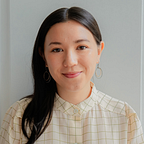Inclusive design at the intersection of immigration, aging, and healthcare
--
Healthcare, especially in the US, is a complex system. And health is a huge factor in how we experience life. Like many others, my experiences with healthcare have been shaped by my cultural background and my family experiences.
I grew up in a bilingual and bicultural household. My mom is a Taiwanese American immigrant — the first and only one of her immediate family in Taiwan to move to the US and become a US citizen. Like many immigrants, my mom’s journey from Taiwan to the US required navigating immense change and overcoming many challenges. She grew up in a small town in Taiwan and became the first in her family to attend college and move to the city. She and my dad met while he was visiting Taipei from the US. After they got married, she immigrated to the US and chose to become a full-time mother. As if navigating all those life changes and the US immigration system wasn’t challenging enough, she also navigated being a first-time mother and the challenges of raising a mixed-race child in America — less than 3 decades after the legalization of interracial marriage. Even more, she figured out how to show up for her family and grieve the illness and loss of her parents and younger sister in Taiwan as the only child living overseas. And over the years, she’s found ways to stay active through exercise and hobbies, friends and communities, and travel. I’m really proud of her for all she’s overcome. I also see how poorly designed systems and a lack of equitable support have created and perpetuated challenges that she shouldn’t have had to face in the first place.
As a bilingual child of parents who have both a shared language and culture but also very different first languages and cultures, I am intimately familiar with language and cultural gaps and the effects they have on everyday life because I witnessed and experienced them at home. But it wasn’t the everyday experiences that I remember most vividly; it was the language gaps and cultural gaps that happened in places where important decisions were being made. Decisions with big, long-term life consequences. Like healthcare decisions.
I’ve seen that culturally unsupportive healthcare experiences can result in disappointment, distrust, fear, and an aversion to US healthcare and Western medicine. Intersecting this with the needs and challenges of aging, it makes experiences like my mom’s even more complicated. Healthcare and aging is a multigenerational experience, especially for immigrant families, yet not every child of immigrants is equipped to most effectively support their loved ones’ health as they grow older. And those who serve as family caregivers often pay a huge cost in precious time and energy that would be better spent on emotional connection and deeper family bonding.
My experiences have made it clear to me that we need supportive and effective care, and solutions that recognize the role that culture, language, and family experiences play in our experience with healthcare and our health outcomes. We also need awareness of how existing healthcare solutions have produced inequitable health outcomes, and who’s been left out or overlooked. We need well-designed systems and healthcare solutions that identify and break down barriers, and center the needs of communities that have been previously overlooked. We need to work with them, offer them the tools to solve problems, and welcome them into the process of designing new systems together.
My mom and my family are not alone. 1 in 5 Americans speak a language other than English at home. Americans age 65+ will double by 2060 and non-white seniors will be almost half of the aging population. Asian and Hispanic Americans are the fastest growing groups of Medicare beneficiaries. This intersection of immigration, aging, and healthcare is a problem space that I’m not only personally connected to, but that I deeply feel is worth attention, investment, and thoughtful design. That’s why I decided to join LingoHealth.
At LingoHealth, I’m proud to be part of a smart, compassionate team that’s taking a community-centered approach to a critical problem. I’m excited to bring my background in UX, product strategy, inclusive design, and enterprise and B2B software to this problem space. I’m also drawing from consumer healthcare tech projects I’ve worked on in the past — around Medicaid, dental care, and childhood asthma management. I’m looking forward to learning all about this space and designing to make aging and healthcare easier for people like my mom.
I believe people like her should have a future with easy access to healthcare options — and tools for aging confidently — that are centered on their needs and designed with their expectations, fears, beliefs, dreams, and desires in mind. I feel lucky to be a part of LingoHealth’s growing community of families, providers, partners, investors, and advisors to design that future together.
If you’re interested in learning more about what we’re doing or know someone who might be interested, I’d love to hear from you! We’re currently looking for business partnerships and immigrant seniors and family caregivers to join our growing community as early members. Feel free to reach out to me directly or visit lingohealth.io to learn more and get in touch 💙
